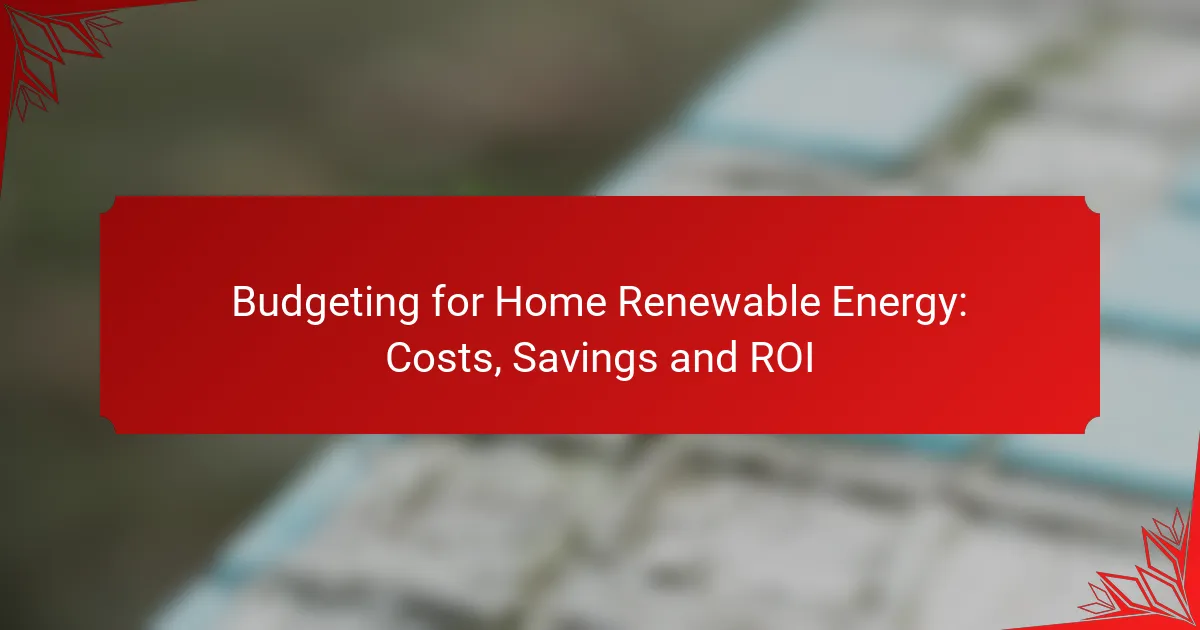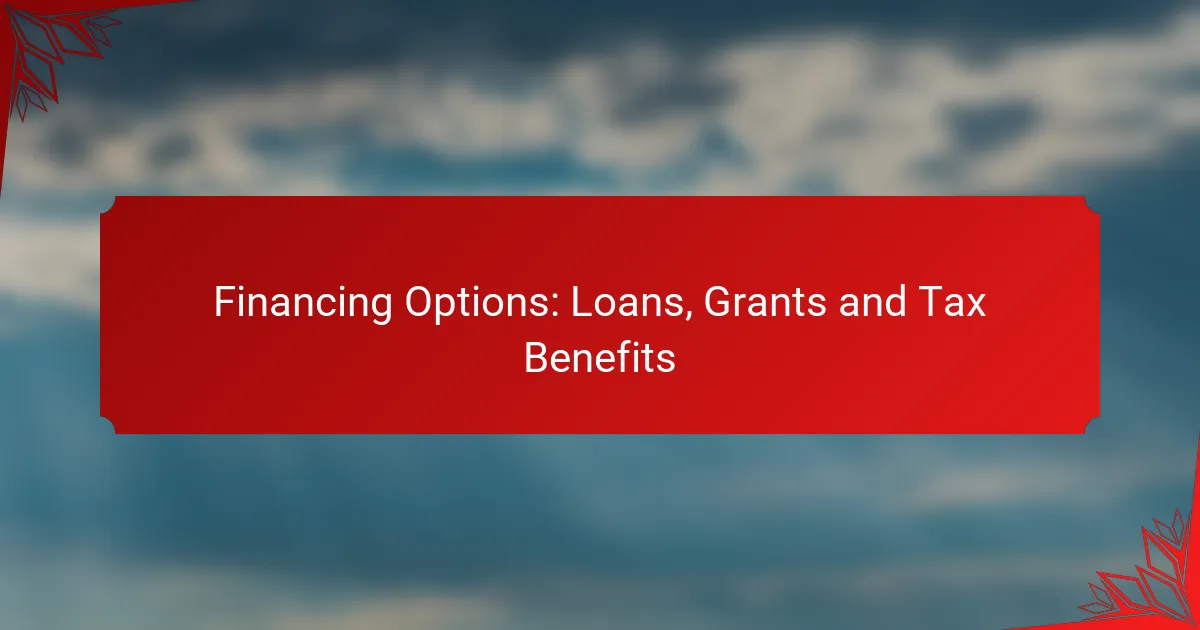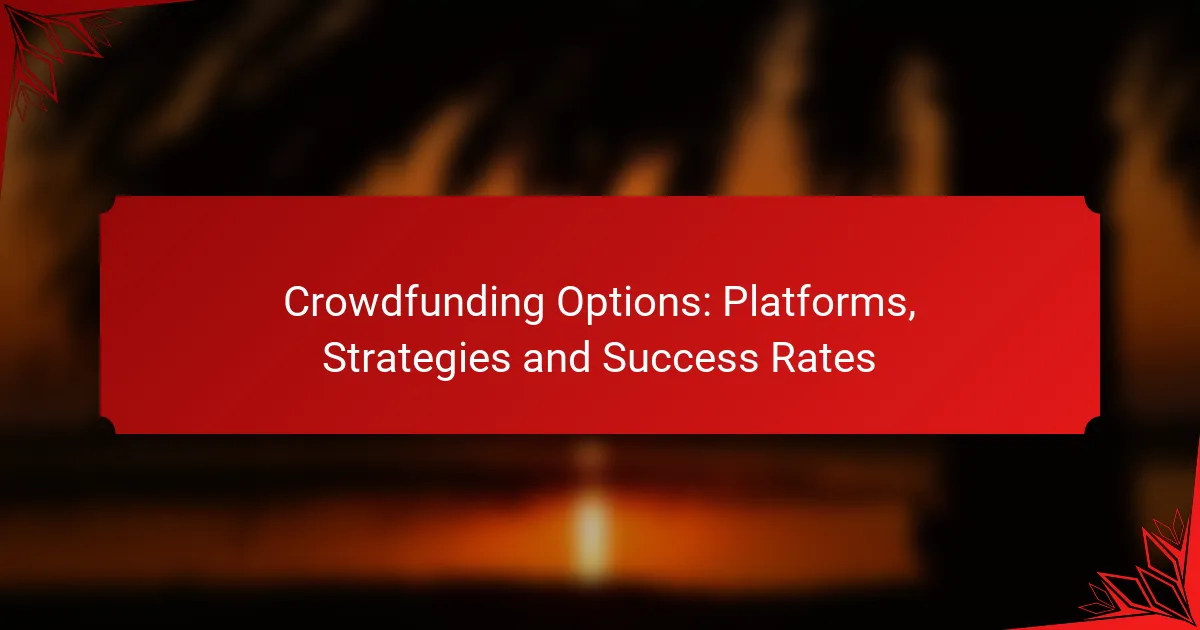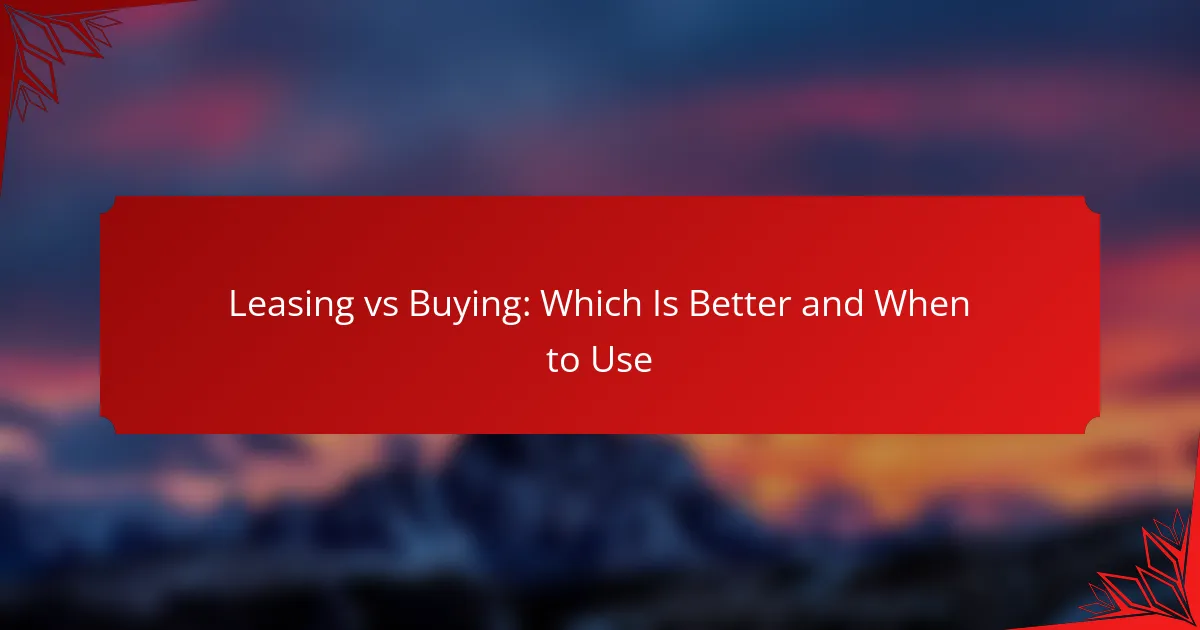Investing in home renewable energy systems can be a significant financial commitment, with initial costs varying based on the type of system and installation complexity. However, these systems offer the potential for substantial long-term savings on energy bills, making them an attractive option for homeowners. With a return on investment (ROI) typically ranging from 5% to 20%, the financial benefits can outweigh the upfront expenses, especially when considering local energy prices and available incentives.

What are the costs of home renewable energy systems in the US?
The costs of home renewable energy systems in the US can vary significantly based on the type of system, installation complexity, and location. Homeowners should expect to invest several thousand dollars upfront, but these systems can lead to substantial long-term savings on energy bills.
Solar panel installation costs
Solar panel installation costs typically range from $15,000 to $25,000 for a standard residential system before incentives. Factors affecting the price include the size of the system, type of panels, and installation labor. Homeowners may also need to consider additional costs for permits and inspections.
It’s essential to compare quotes from multiple installers to find the best deal. Look for companies with good reviews and experience in your area to ensure quality installation.
Wind turbine installation costs
Wind turbine installation costs can range from $30,000 to $70,000 depending on the turbine size and site conditions. Smaller residential turbines may cost less, but they require sufficient wind resources to be effective. Homeowners should evaluate local wind patterns before investing.
Installation may also involve additional expenses such as site preparation and connection to the electrical grid. Researching local regulations and zoning laws is crucial to ensure compliance.
Battery storage system costs
Battery storage systems for home renewable energy can cost between $5,000 and $15,000, depending on capacity and technology. These systems store excess energy generated from solar panels or wind turbines for use during peak demand or outages. The initial investment can be offset by savings on energy bills.
When selecting a battery system, consider the energy needs of your household and the expected lifespan of the batteries. Look for warranties that cover at least 10 years to ensure longevity.
Government incentives and rebates
Government incentives and rebates can significantly reduce the upfront costs of renewable energy systems. In the US, the federal solar tax credit allows homeowners to deduct a percentage of the installation costs from their federal taxes. Many states and local governments also offer additional incentives.
Homeowners should research available programs in their state, as these can change frequently. Websites like the Database of State Incentives for Renewables & Efficiency (DSIRE) provide updated information on incentives.
Financing options available
Financing options for home renewable energy systems include personal loans, home equity loans, and solar leases. Many installers also offer financing plans that allow homeowners to pay for their systems over time, often with little to no upfront costs.
Before committing to a financing option, evaluate the total cost of financing, including interest rates and terms. Comparing multiple offers can help find the most affordable solution for your budget.

How much can homeowners save with renewable energy?
Homeowners can save significantly on energy costs by investing in renewable energy sources like solar or wind. Savings vary based on system size, local energy prices, and available incentives, but many see reductions in their monthly bills and long-term financial benefits.
Monthly energy bill reductions
Switching to renewable energy can lead to immediate reductions in monthly energy bills. Homeowners may experience savings ranging from 20% to 50%, depending on their energy consumption and the efficiency of their renewable systems. For example, a solar panel system can offset a substantial portion of electricity costs, especially in regions with high sunlight exposure.
It’s essential to consider the initial investment and financing options, as these can affect the overall savings. Many homeowners opt for solar loans or leases, which can further reduce upfront costs and enhance monthly savings.
Long-term savings over 20 years
Over a 20-year period, homeowners can realize substantial savings from renewable energy investments. Estimates suggest that solar energy systems can save homeowners tens of thousands of dollars over their lifespan, particularly as utility rates continue to rise. The cumulative effect of these savings can significantly outweigh the initial installation costs.
Additionally, many renewable energy systems require minimal maintenance, which can further enhance long-term savings. Homeowners should also consider the potential increase in property value, as homes with renewable energy installations often attract higher resale prices.
Impact of net metering
Net metering allows homeowners with renewable energy systems to sell excess energy back to the grid, further enhancing savings. This practice can lead to credits on monthly utility bills, effectively reducing costs even more. The specific benefits of net metering depend on local regulations and utility policies, which can vary widely.
Homeowners should research their state’s net metering policies to understand potential savings. In some areas, net metering can significantly shorten the payback period for renewable energy investments, making them even more financially attractive.
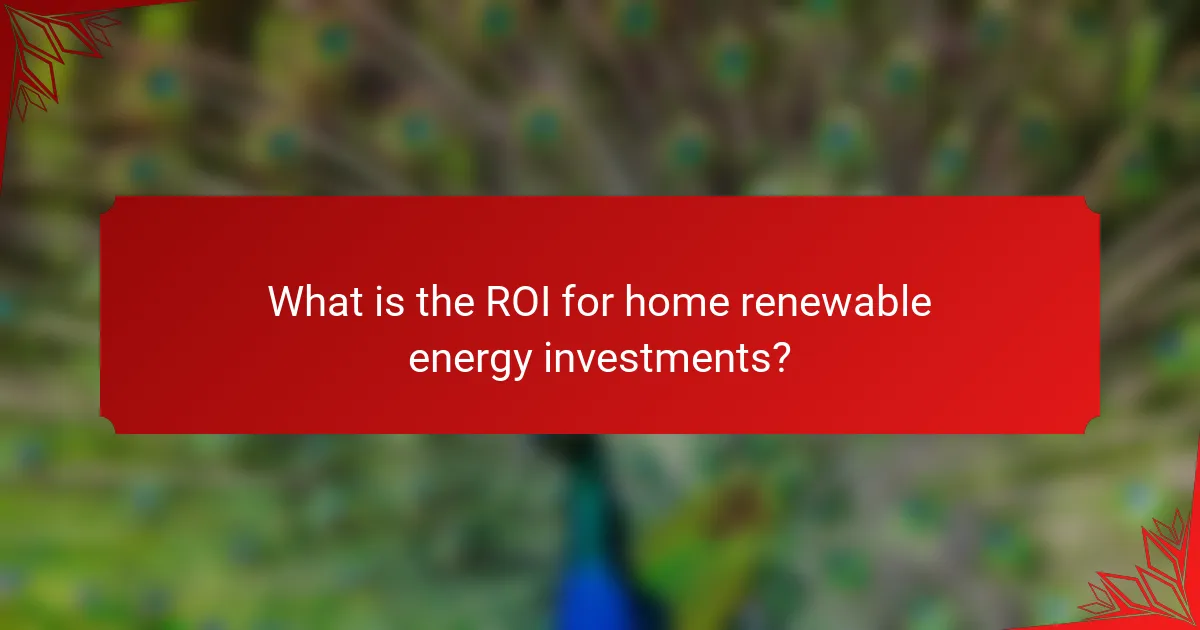
What is the ROI for home renewable energy investments?
The return on investment (ROI) for home renewable energy investments measures the financial gains from installing systems like solar panels or wind turbines compared to their initial costs. Generally, homeowners can expect an ROI ranging from 5% to 20%, depending on various factors such as system type, location, and energy savings.
Average payback period
The average payback period for home renewable energy systems typically ranges from 5 to 10 years. This timeframe reflects how long it takes for energy savings to equal the initial investment. For example, if a solar panel system costs $15,000 and saves $2,000 annually on energy bills, the payback period would be 7.5 years.
Homeowners should consider local incentives, such as tax credits or rebates, which can significantly shorten the payback period. In some regions, these incentives can cover a substantial portion of the installation costs, making the investment more appealing.
Factors affecting ROI
Additionally, the orientation and shading of a property can affect solar panel performance, impacting overall ROI. Homeowners should conduct a site assessment to determine the best placement for optimal energy production.
Comparative ROI of solar vs. wind
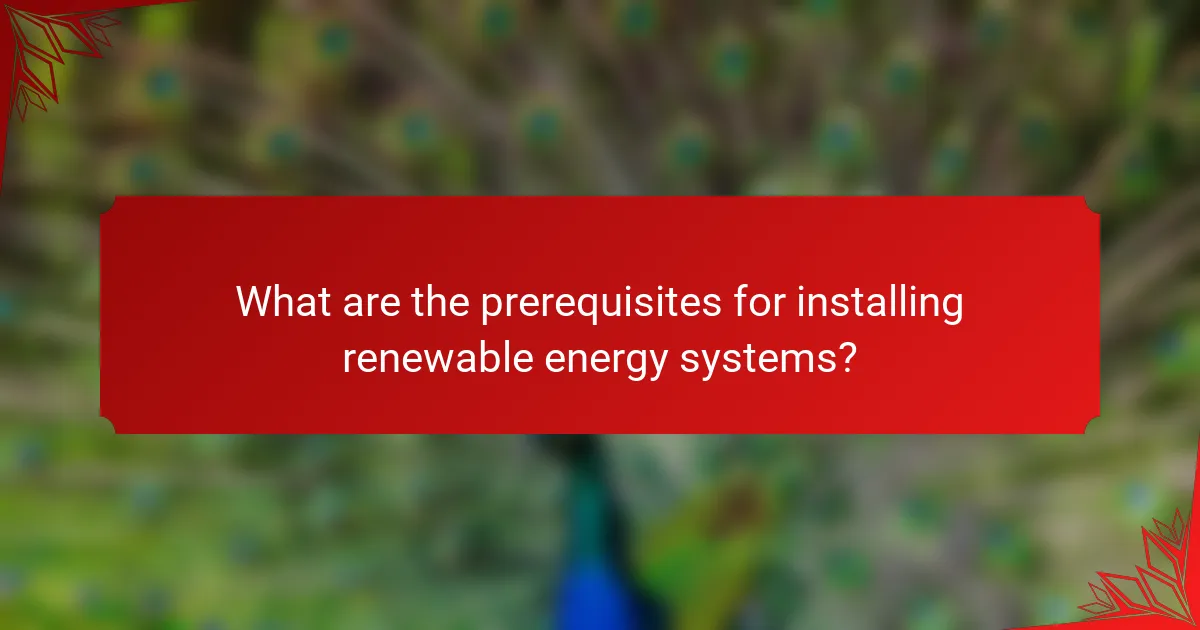
What are the prerequisites for installing renewable energy systems?
Before installing renewable energy systems, homeowners should evaluate their energy needs and local regulations. Understanding these prerequisites ensures a smoother installation process and maximizes the benefits of renewable energy.
Home energy assessment requirements
A home energy assessment is essential to determine the current energy consumption and efficiency of your home. This assessment typically involves a professional evaluation of insulation, heating and cooling systems, and overall energy usage patterns.
Homeowners can expect to receive recommendations for improvements that may enhance energy efficiency before installing renewable systems. These improvements can include upgrading insulation or sealing air leaks, which can lead to substantial energy savings.
Local zoning and permitting regulations
Local zoning and permitting regulations vary by region and can significantly impact the installation of renewable energy systems. Homeowners should check with local authorities to understand specific requirements, such as permits for solar panels or wind turbines.
In many areas, obtaining a permit may involve submitting plans and undergoing inspections. Failing to comply with these regulations can result in fines or the need to remove installed systems, so it’s crucial to research and adhere to local guidelines.

How to choose the right renewable energy system for your home?
Choosing the right renewable energy system for your home involves assessing your energy needs, evaluating available technologies, and considering your budget. Key factors include the type of renewable energy source, installation costs, and potential savings on energy bills.
Evaluating energy needs
Start by determining your household’s energy consumption, typically measured in kilowatt-hours (kWh). Review past utility bills to find your average monthly usage, which can help you understand how much energy you need to generate with a renewable system.
Consider factors such as the size of your home, the number of occupants, and your lifestyle. For example, a family with multiple electronic devices may require more energy than a single-person household. This assessment will guide you in selecting the appropriate system capacity.
Additionally, think about future energy needs. If you plan to add electric vehicles or expand your home, factor these potential increases into your calculations. This foresight can prevent the need for costly upgrades later on.
